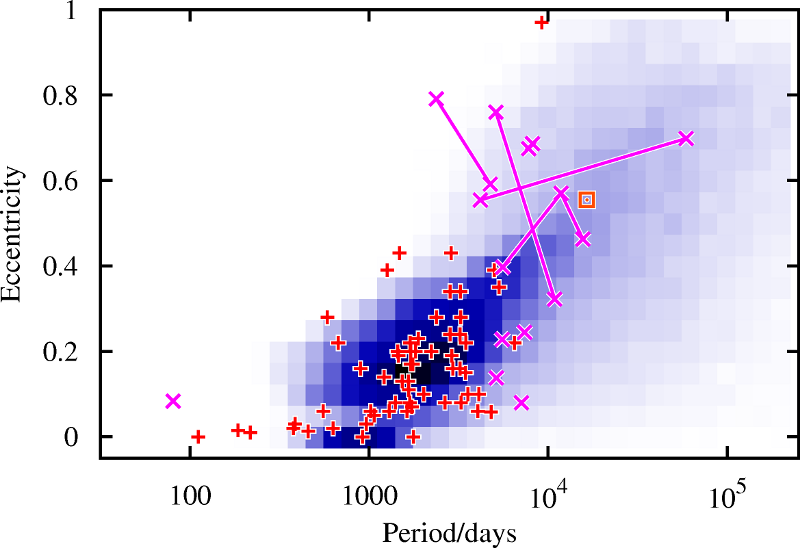| White-Dwarf Kicks and Implications for Barium Stars |
| Izzard, R. G.; Dermine, T.; Church, R. P. |
| We investigate the impact of white-dwarf kicks on the orbital properties of barium stars. By combining moderate kicks of a few km s-1, efficient common-envelope ejection and angular momentum loss during non-conservative wind mass transfer we can better reproduce the observed period-eccentricity distribution. |
 |
The period-eccentricity distribution of barium stars with kicks much better agrees with the observations.
|
|
| Accepted for publication in Astronomy and Astrophysics, see also arXiv:1008.3818 |
| Fast rotating stars resulting from binary evolution will often appear to be single |
| de Mink, S. E.; Langer, N.; Izzard, R. G. |
| The fate of a 20+15 M⨀ close binary as a function of initial period. |
 |
|
Rapidly rotating stars are readily produced in binary systems. An accreting star in a binary system or a merged binary can be rapidly spinning. These rapid rotators may appear as Be or Oe stars or at low metallicity they may be progenitors of long gamma-ray bursts. We investigate the properties of binary stars that masquerade as single stars.
|
| Proceedings of IAU 272 "Active OB stars: structure, evolution, mass loss and critical limit", Paris 19-23 July 2010 |
| Massive binaries and the enrichment of the interstellar medium in globular clusters |
| de Mink, S. E.; Pols, O. R.; Langer, N.; Izzard, R. G. |
| Abundance anomalies observed in globular cluster stars indicate pollution with material processed by hydrogen burning. Two main sources have been suggested: asymptotic giant branch (AGB) stars and massive stars rotating near the break-up limit (spin stars). We discuss the idea that massive binaries may provide an interesting alternative source of processed material. We discuss observational evidence for mass shedding from interacting binaries. In contrast to the fast, radiatively driven winds of massive stars, this material is typically ejected with low velocity. We expect that it remains inside the potential well of a globular cluster and becomes available for the formation or pollution of a second generation of stars. We estimate that the amount of processed low-velocity material that can be ejected by massive binaries is larger than the contribution of the two previously suggested sources combined. |
| Proceedings of IAU Symposium 266: Star Clusters, Basic Galactic Building Blocks Throughout Time And Space |
| Carbon-enhanced metal-poor stars as probes of early Galactic nucleosynthesis |
| Pols, O. R.; Izzard, R. G.; Glebbeek, E.; Stancliffe, R. J. |
| A large fraction, between 10 and 25%, of very metal-poor stars in the Galactic halo are carbon-rich objects, with enhancements of carbon relative to iron exceeding a factor 10. The majority of these carbon-enhanced metal-poor (CEMP) stars show enhancements of heavy s-process elements and have been found to be spectroscopic binary systems. Many of their properties are well explained by the binary mass transfer scenario, in which a former asymptotic giant branch (AGB) companion star has polluted the low-mass star with its nucleosynthesis products. The same scenario predicts the existence of nitrogen-rich metal-poor (NEMP) stars, with [N/C] > 0.5, from AGB companions more massive than about 3 solar masses. In contrast to CEMP stars, however, such NEMP stars are very rare. Recent studies suggest that the high frequency of CEMP stars requires a modified initial mass function (IMF) in the early Galaxy, weighted towards intermediate-mass stars. Such models also implicitly predict a large number of NEMP stars which is not seen. |
| Proceedings of IAU Symposium 265: Chemical Abundances in the Universe, Connecting First Stars to Planets |
| Light elements in massive single and binary stars |
| Langer, N.; Brott, I.; Cantiello, M.; de Mink, S. E.; Izzard, R. G.; Yoon, S.-C. |
| We highlight the role of the light elements (Li, Be, B) in the evolution of massive single and binary stars, which is largely restricted to a diagnostic value, and foremost so for the element boron. However, we show that the boron surface abundance in massive early type stars contains key information about their foregoing evolution which is not obtainable otherwise. In particular, it allows to constrain internal mixing processes and potential previous mass transfer event for binary stars (even if the companion has disappeared). It may also help solving the mystery of the slowly rotating nitrogen-rich massive main sequence stars. |
| Proceedings of IAU Symposium 268: Light elements in the Universe |
| GALEV Evolutionary Synthesis Models: Why Are They Special? |
| Anders, Peter; Kotulla, R.; Izzard, R.; Brott, I. |
| One of the major challenges in modern astrophysics is the study of how galaxies have formed and evolved over the past Hubble time. Observationally, ever larger surveys are or will be carried out to widen our horizon by studying increasingly faint and more distant objects in greater number and tremendous detail. Complementary, studies of nearby star clusters can reveal the state of their host galaxy during cluster formation. Adequate models to extract the physical quantities of the studied objects in a reliable, accurate and physically sound way are needed to exploit these observations. Our GALEV evolutionary synthesis models offer an excellent answer to fulfill this urgent demand. |
| Proceedings of AAS Meeting 215 |

